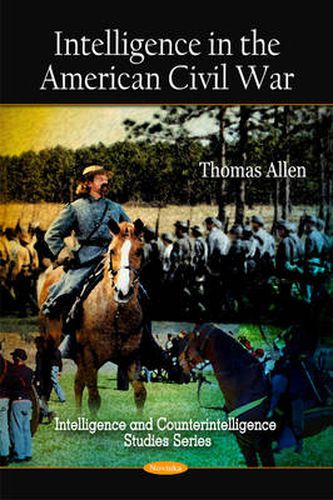Intelligence in the American Civil War
Thomas Allen

Intelligence in the American Civil War
Thomas Allen
Though much has been written about the American Civil War itself, little has been written about the spy war that went on within. The chronicling of Civil War intelligence activities challenges historians because of the lack of records, the lack of access to records, and the questionable truth of other records. Judah P. Benjamin, the Confederacy’s Secretary of State, burned all the intelligence records he could find as federal troops entered Richmond. Union intelligence records were kept sealed in the National Archives until 1953. A few individuals involved in intelligence gathering burned their personal papers while others chose to publish their memoirs, though greatly embellishing their exploits. Even today, the identities of many spies remain secret. Henry Thomas Harrison, for example, was a Confederate spy whose intelligence set in motion the events that produced the battle of Gettysburg. But neither his first name nor details of his long career as a spy were known until 1986, when historian James O. Hall published an article about him. Though the idea of centralised intelligence gathering was decades away, the age-old resistance to the idea was present even then. Neither side saw the need to create such intelligence organisations, but each side approached the idea of effectively acquiring intelligence in their own way. The Confederacy’s Signal Corps, devoted primarily to communications and intercepts, included a covert agency, the Secret Service Bureau. This unit ran espionage and counter-espionage operations in the North. Late in the war, the bureau set up a secret headquarters in Canada and sent out operatives on covert missions in Northern states. The Union’s Bureau of Military Information, unlike the Confederacy’s Secret Service Bureau, operated for specific generals rather than for the Union Army itself. But here was born the idea of what would eventually become a centralised military intelligence division. Each side still used age-old intelligence techniques, such as code-breaking, deception, and covert surveillance. However, into this modern war came two innovations that would endure as tools of espionage: wiretapping and overhead reconnaissance. What follows is a look at some of the highlights of how the North and the South gathered and used their information, the important missions, and the personalities. From this special view, the focus is not on the battlefield, but on a battle of wits.
This item is not currently in-stock. It can be ordered online and is expected to ship in approx 4 weeks
Our stock data is updated periodically, and availability may change throughout the day for in-demand items. Please call the relevant shop for the most current stock information. Prices are subject to change without notice.
Sign in or become a Readings Member to add this title to a wishlist.


